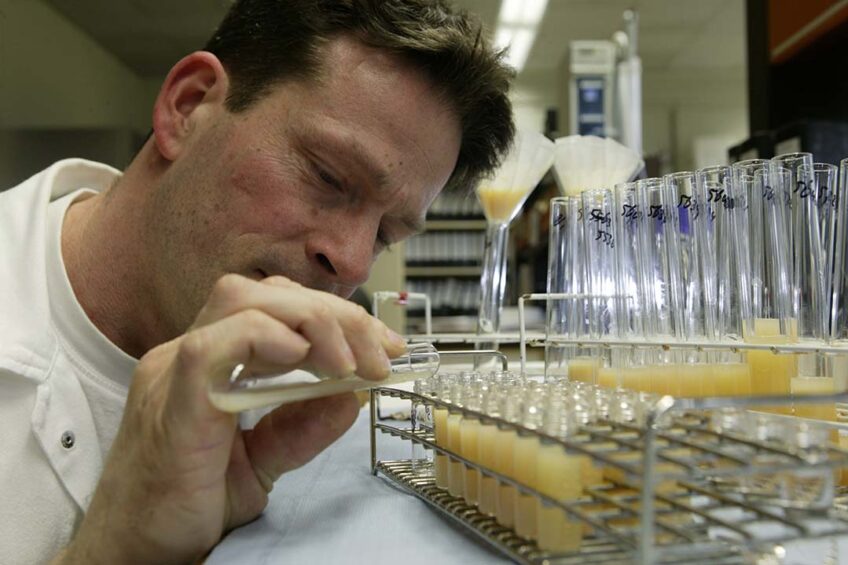Eliminating the major egg allergen ovomucoid in chickens

Researchers have used genome editing technology to produce eggs without the ovomucoid protein that causes egg white allergies. They found that the eggs from genetically altered hens did not have ovomucoid or mutations of ovomucoid. Research detailing the food safety profile of this modified egg was published in the journal of Food and Chemical Toxicology.
Reports show that chicken egg allergies are one of the most common allergies in children. Although most children outgrow this allergy, some will still have an egg allergy into adulthood. Egg white allergies can cause a variety of symptoms, including vomiting, stomach cramps, breathing problems and swelling, and some people with egg white allergies are unable to receive certain influenza vaccines.
The major allergens in hen eggs are ovomucoid, ovalbumin, ovotransferrin and lysozyme, among which ovomucoid is the most predominant allergen protein. Ovomucoid accounts for approximately 11% of all the protein in egg whites. By contrast, allergens other than ovomucoid may be inactivated or denatured by processing with heat or digestive enzymes to eliminate allergen-inducibility.
Previous studies have shown that physical removal of ovomucoid from egg white can be done via solvent extraction and rinsing of boiled egg white. However, the complete removal of ovomucoid could not be achieved without impairing egg white characteristics, such as gelation and foaming. Ovomucoid is very resistant to heat and digestive enzymes, making it difficult to remove through physiochemical methods. Thus, if chicken eggs can be produced without ovomucoid, processed chicken eggs deficient in allergen-inducing properties can be produced. Therefore, ovomucoid-knockout chicken eggs can be effectively used to solve the allergy problem in food and vaccines.
In the present study, the researchers generated ovomucoid-knockout chickens using exon1-targeted TALENs (transcription activator-like effector nuclease), produced ovomucoid-free eggs and evaluated their safety.
Producing ovomucin-free eggs
In this study, the genome editing target was designed for exon 1 of the ovomucoid protein. The researchers introduced ovomucoid mutations and performed genome editing to target exon 1 using transcription activator-like effector nuclease (TALEN) with variable repeats, known as platinum TALENs.
Simply put, TALENs are restriction enzymes that recognise specific DNA sequences and break or cut them. They used platinum TALENs as they have higher DNA cleavage activity than conventional TALENs with constant repeats. They aimed to produce a frameshift mutation that could cause the signal peptide to produce chickens that do not produce ovomucoid and not accumulate by-products in chicken eggs. Using the ELISA technique ovomucoid could not be detected in the egg whites of ovomucoid homozygous knockout hens.
What is usually observed is that when an organism that has undergone gene knockout by genome editing is applied as a food product, it is not certain that the mutant protein will not be expressed from the mutated allele. With this thought in mind, the researchers performed whole genome sequencing analysis in ovomucoid-knockout individuals to assess the possibility of vector integration and off-target effects.
With whole genome sequencing analysis they found that ovomucoid-knockout chickens did not show vector integration and the potential TALEN-induced off-target effects were localised in intergenic (the DNA regions between the coding genes) and intron regions that are usually not part of the mature mRNA molecule and do not code for amino acids that make up the protein encoded by the target gene.
“The WGS information confirmed that plasmid vectors used for genome editing were only transiently present and did not integrate into the genome of edited chickens,” they reported. “These results indicated that mature ovomucoid was absent in ovomucoid-null eggs. The eggs laid by homozygous ovomucoid-knockout hens showed no evident abnormalities and immunoblotting showed that the albumen contained neither the mature ovomucoid nor the ovomucoid truncated variant.”
Evaluating the safety of ovomucoid-free eggs
To be able to use this ovomucoid-knockout chicken egg as food it is necessary to evaluate its safety. In this study, the researchers therefore examined the presence or absence of mutant protein expression, vector sequence insertion and off-target effects in chickens knocked-out of ovomucoid by platinum TALENs.
In previous studies, ovomucoid and ovomucoid mutants from ovomucoid-null eggs have been detected using anti-ovomucoid antibodies, focusing on in-frame mutants. However, it is expected that the detection of mutants will be insufficient with anti-ovomucoid antibodies alone. In the current study the researchers used both anti-ovomucoid and anti-mutant ovomucoid antibodies to detect ovomucoid and ovomucoid mutants from ovomucoid -null eggs, respectively.
The results showed no evident abnormalities in eggs produced from ovomucoid-knockout hens; the ovomucoid was completely removed from the ovomucoid-null eggs and ovomucoid mutants which could be caused by the frameshift were not detected.
“This eliminates the possibility that the ovomucoid mutants that may result from the frameshift may become new allergens in foods made from ovomucoid-null eggs,” they said. “These results indicate the importance of safety evaluations and reveal that the eggs laid by this ovomucoid-knockout chicken could solve the allergy problem in food and vaccines.”
Focus on immunological and clinical investigations
Looking to the future, the researchers will continue to verify the safety profile of the ovomucoid-knockout eggs, as research shows some people are highly allergic to this specific protein even when present in small amounts. For this the researchers emphasised the need to perform additional immunological and clinical studies to determine the safety of these ovomucoid-knockout eggs.
However, for the moment, the researchers have determined that ovomucoid-knockout eggs are less allergenic than standard eggs and can be safely used to solve the egg-related allergy problem in food and vaccines. “As the results indicate the importance of safety evaluation, the next phase of the research will be to evaluate the physical properties and processing suitability of ovomucoid-knockout eggs, and practical application to confirm their efficacy through clinical trials,” they concluded.












